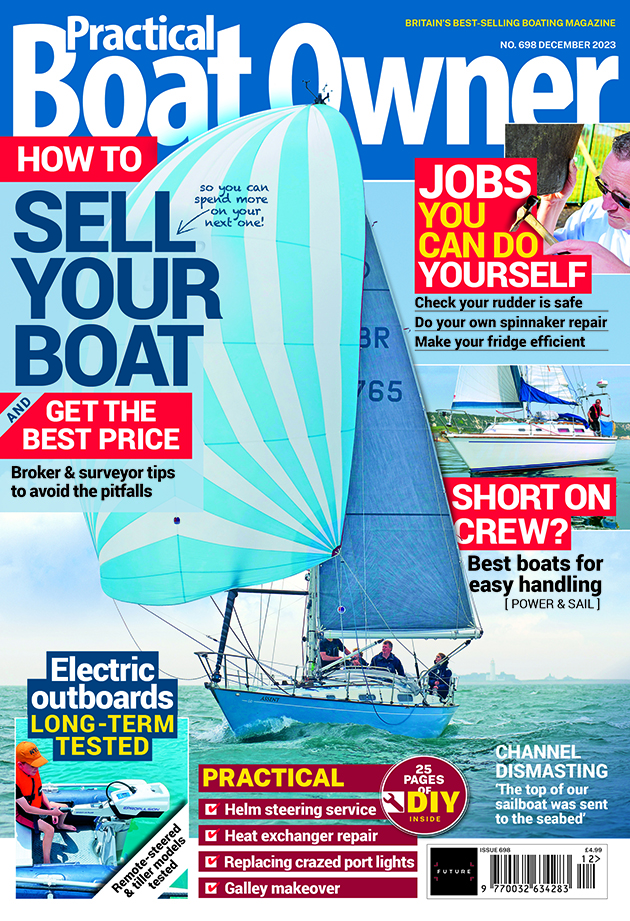When cruising in powerboats, especially small open boats, safety is paramount. Jake Kavanagh shares his advice for relaxed high-speed adventures around the coast and at sea
When cruising in powerboats long distance, across wide spaces of ocean, extra precautions are necessary.
The most obvious is that boats have enough fuel – with a 20% reserve – to make it or divert to the nearest safe haven if the weather takes a turn.
Extra two-stroke engine oil should also be carried for those who need it.

Before setting out, make sure you have planned safe havens, in case the weather turns
Accommodation ashore should be booked in advance, as few smaller boats are able to accommodate crew overnight.
It is a good idea to carry your passport, even if not needed for the trip (to the Channel Islands, for instance) just in case France becomes a bolt hole.
Great care should be taken with the weather, and it is advisable to work out how to get home without the boat in advance, just in case.
It is better to come back later for it than take a risk in marginal weather.
Cruising in powerboats: equipment
The emphasis of small powerboat cruising is safety.
This means always knowing where you are, always being able to stay warn hydrated and fed, and having enough tools and fuel to cope with all but the most dramatic breakdown.
If you really can’t sort a problem out, then you also have to be able to summon help quickly and definitively.
Below is a list of essential gear that should be carried as routine.
Communication:
- Fixed VHF radio
- Handheld VHF radio
- Mobile phone
Distress:
- Flares
- Personal EPIRB
- PLB
Navigation:
- Fixed compass
- GPS/chart plotter
- Charts
- Detailed passage plan
Comfort/Safety:
- Lifejackets
- Wet weather gear
- Dry clothes/survival blanket
- Food/hot drinks
- First Aid Kit
Safety/Repairs:
- Tool kit
- Spare prop
- Spare fuel/oil
- Spare belts/impellers
- Anchor
- Towlines
Powerboat cruising kit close up
Lifejackets vs Buoyancy Aids
Many powerboaters wear automatic lifejackets rather than buoyancy aids, mainly because an automatic lifejacket should, in theory, roll an unconscious casualty the right way up and keep their face clear of the water.
A buoyancy aid will keep the swimmer upright and vertical, but it allows the head to slump forward into the water.

It is a matter of choice whether you wear a lifejacket or a buoyancy aid
Many RIBsters, however, still prefer the buoyancy aid, arguing that the foam padding acts as body armour should you get thrown against a console or an A-frame, and also acts as a spray deflector.
Buoyancy aids also have front pockets, which are useful for keeping a watertight bag holding a phone or a chocolate bar handy.
Helmets
Some RIB crews wear a helmet in rough weather.
If the RIB stuffs itself into a wave, the helmet will absorb a blow from the console or windscreen, many of which seem to be placed right where they can brain you.

Helmet are advisable, especially when it gets rough
Better still, a helmet makes the journey less tiring by reducing wind noise and dehydration.
A decent visor also stops the stinging spray.
Talking of spray, many RIBsters find tinted skiing goggles to be useful.
The best types are fully waterproof, with vents to avoid misting up, and are large enough to accommodate a pair of sunglasses underneath.
Charts
A favourite for small powerboats is the Admiralty Small Craft Series, which come as a large-scale portfolio with useful harbour plans inset.
They are small enough to be passed through a laminator, meaning they can be made fully waterproof and can be written on with a china marker pencil.
They can then be rolled up and stowed in a tube onboard.
Continues below…
How I built a bespoke aluminium powerboat at home
Late in 2015, just as James Oakley was finishing the hull of his home-built aluminium speedboat, he was diagnosed with…
RS Pulse 63 test drive review: Could this electric RIB change the world?
When RS Sailing, the world’s largest manufacturer of sailing dinghies, announced a few years ago that it would be building…
How to service a 2-stroke outboard engine
After a long winter indoors many 2-stroke outboards are reluctant to start. A simple service should make yours more reliable.…
Family sailing safety gear: TESTED!
Ali Wood discusses the sailing safety gear she chose for their first family cruise on board their Maxi 84, and…
Most of the passage planning is done in advance, with distances and landmarks transcribed to a whiteboard, which is kept near the helm console.
It is also possible to get stick-down/tear-off writing pads, which can be put to use beside the helm.
A good anchor is essential for mooring off idyllic coves and beaches.
A favoured anchor is the Bruce, even though it doesn’t stow well, followed by the Danforth, which stows flat.

Bruce anchor
Because RIBS and small sportsboats have a bow configuration that makes anchoring difficult, the painter is tied to the anchor rope instead, so there is no need to lean over the bow.
Chart plotter/GPS
The easiest GPS systems for use in a fast moving powerboat involve big buttons, or a large multi-function scrolling tool.
Enjoyed reading Cruising in powerboats long distance: a quick guide? 
A subscription to Practical Boat Owner magazine costs around 40% less than the cover price.
Print and digital editions are available through Magazines Direct – where you can also find the latest deals.
PBO is packed with information to help you get the most from boat ownership – whether sail or power.
-
-
-
- Take your DIY skills to the next level with trusted advice on boat maintenance and repairs
- Impartial in-depth gear reviews
- Practical cruising tips for making the most of your time afloat
-
-








